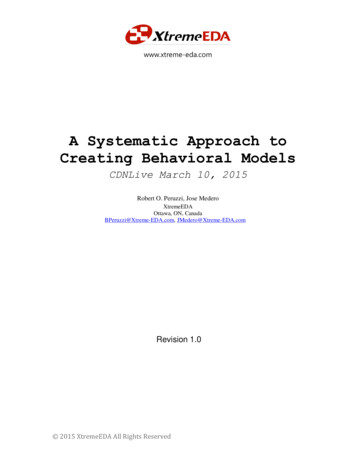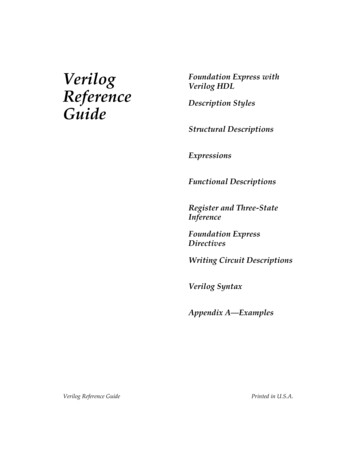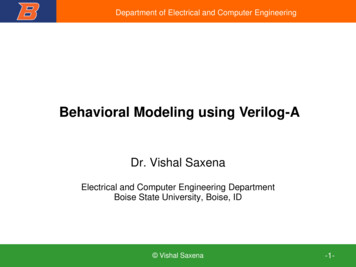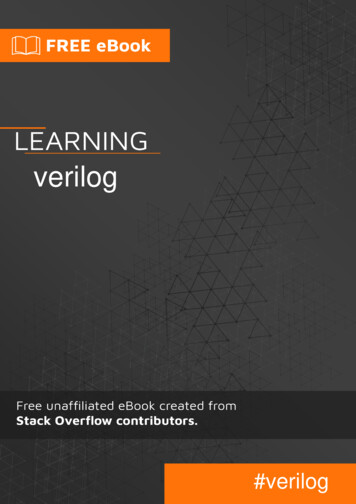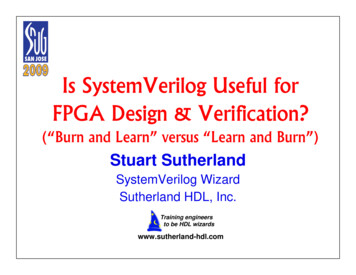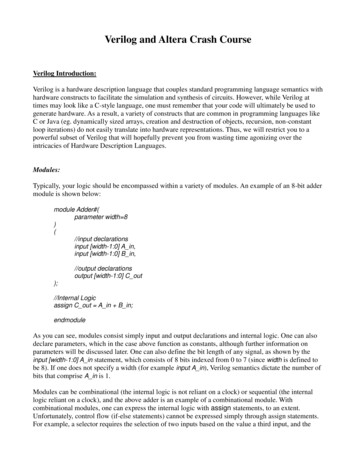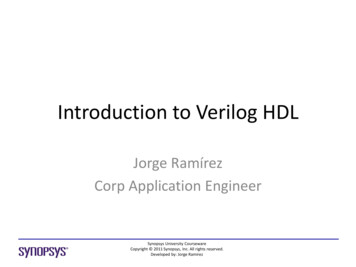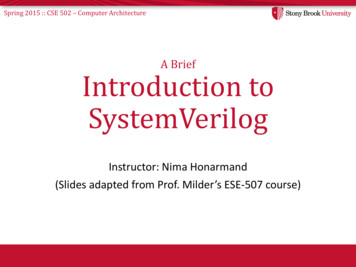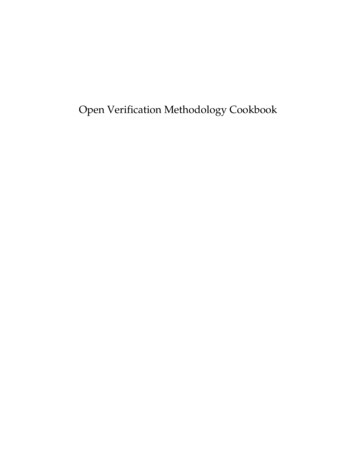
Transcription
Open Verification Methodology Cookbook
Mark GlasserOpen Verification MethodologyCookbook
Mark GlasserMentor Graphics Corporation8005 SW Boeckman RoadWilsonville, OR 97070USAmark glasser@mentor.comISBN 978-1-4419-0967-1e-ISBN 978-1-4419-0968-8DOI 10.1007/978-1-4419-0968-8Springer Dordrecht Heidelberg London New YorkLibrary of Congress Control Number: 2009930147 Mentor Graphics Corporation, 2009All rights reserved. This work may not be translated or copied in whole or in part without thewritten permission of the publisher (Springer Science Business Media, LLC, 233 Spring Street,New York, NY 10013, USA), except for brief excerpts in connection with reviews or scholarlyanalysis. Use in connection with any form of information storage and retrieval, electronicadaptation, computer software, or by similar or dissimilar methodology now known or hereafterdeveloped is forbidden. The use in this publication of trade names, trademarks, service marks,and similar terms, even if they are not identified as such, is not to be taken as an expression ofopinion as to whether or not they are subject to proprietary rights. The author and publisher havetaken care in the preparation of this book, but make no expressed or implied warranty of anykind and assume no responsibility for errors or omissions. No liability is assumed for incidentalor consequential damages in connection with or arising out of the use of the information orprograms contained herein.Go to http://www.mentor.com/cookbook for more information about the Open VerificationMethodology and to obtain the OVM Cookbook kit of examples.Printed on acid-free paperSpringer is part of Springer Science Business Media (www.springer.com)
To JaniceTo all verification engineers, the unsung heros of the designworld, who toil over their testbenches so systems will work,and who receive satisfaction from a job well done.
PrefaceWhen I need to learn a new piece of software I invent a little problem formyself that is within the domain of the application and then set out to solve itusing the new tool. When the software package is a word processor, I’ll use itto write a paper or article I’m working on; when the software is a drawingtool, I’ll use it to draw some block diagrams of my latest creation. In thecourse of solving the problem, I learn how to use the tool and gain a practicalperspective on which features of the tool are useful and which are not.When the new software is a programming environment or a newprogramming language, the problem is a little different. I can’t just apply thenew language or environment to an existing problem. Unless I’m alreadyfamiliar with the language, I don’t want to commit to using it in a newdevelopment project. On the other hand, I may have an inkling that it wouldbe best to use the new language. Otherwise, why would I be interested in it inthe first place? I need a small program to help me understand thefundamental features and get a feel for how the language works. Theprogram must be small and succinct, something I can write quickly anddebug easily. Yet, it must use interesting language features I wish to learn.Brian Kernighan and Dennis Ritchie solved this problem for all of us whenthey wrote the famous “Hello World” program. In their classic book The CProgramming Language, they started off with a program that is arguably themost trivial program you could write in C that still does something. Thebeauty of Hello World is in its combination of simplicity and completeness.The program quoted here in its entirety, is not only simple, it also contains allof the constructs of a complete C program.#include stdio.h main(){printf(“hello, world\n”);}All those years ago, I typed the program into my text editor, ran cc and ld,and a few seconds later saw my green CRT screen flicker with:hello, world
viiiGetting that simple program working gave me confidence that C wassomething I could conquer. I haven’t counted how much C/C code I’vewritten since, but it’s probably many hundreds of thousands of lines. I’vewritten all manner of software, from mundane database programs to exoticmulti-threaded programs. It all started with Hello World.The Open Verification Methodology (OVM) is a programming environmentbuilt upon SystemVerilog. It is designed to enable the development ofcomplex testbenches. Like C (or SystemVerilog or SystemC), it will take sometime and effort to study the OVM and understand how to apply all theconcepts effectively. The goal of this book is to give you the confidence thatrunning Hello World gave me all those years ago. If I, the author of this book,have done my job reasonably well, then somewhere along the way, as youread this book and exercise the examples, you should experience an aha! Themetaphorical light bulb in your brain will turn on, and you will grasp theoverall structure of the OVM and see how to apply it.The premise of this book is that most engineers, like me, want to jump rightinto a new technology. They want to put their hands on it, try it out and seehow it feels, learn the boundaries of what kinds of problems it addresses, anddevelop some practical experience. This is why quickstart guides and onlinehelp systems are popular. Generally, we do not want to read a lengthy manualand study the theory of operation first. We would rather plunge in, and later,refer to the manual only when and if we get stuck. In the meantime, as weexperiment, we develop a general understanding of what the technology isand how to perform basic operations. Later, when we do crack open themanual, the details become much more meaningful.This book takes a practical approach to learning about testbench construction.It provides a series of examples, each of which solves a particular verificationproblem. The examples are thoroughly documented and complete anddelivered with build and run scripts that allow you to execute them in asimulator and observe their behavior. The examples are small and focused soyou don’t have to wade through a lot of ancillary material to get to the heartof an example.This book presents the examples in a linear progression—from the most basictestbench, with just a pin-level stimulus generator, monitor, and DUT, tofairly sophisticated uses that involve stacked protocols, coverage, andautomated testbench control. Each example in the progression introducesnew concepts and shows you how to implement those concepts in astraightforward manner. Start by examining the first example. When you feelcomfortable with it, move on to the second one. Continue in this manner,mastering each example and moving to the next.
ixThe examples in the cookbook are there for you to explore. After you run anexample, study the code to really understand its construction. Thedocumentation provided with each example serves as a guidepost to pointyou to the salient features. Use this as a starting point to study the codeorganization, style, and other implementation details not explicitly discussed.Play with the examples, too. Change the total time of simulation to see moreresults, modify the stimulus, add or remove components, insert printstatements, and so on. Each new thing you try will help you more fullyunderstand the examples and how they operate.Feel free to use any of the code examples as templates for your work. Forpieces that you find useful, cut and paste them into your code, or use them asa way to start developing your own verification infrastructures. Mainly,enjoy!Mark Glasser, January 2009Organization of This BookChapter 1. Describes some general principles of verification and establishes aframework for designing testbenches based on two questions—Does it work?and Are we done?Chapter 2. This chapter provides an introduction to object-orientedprogramming and how OO techniques are applied to functional verification.Chapter 3. Here, I introduce transaction-level modeling (TLM). Thefoundation of OVM is based on TLM. I illustrate basic put, get, and transportinterfaces with examples.Chapter 4. This chapter explains the mechanics of OVM, illustrating how tobuild hierarchies of class-based verification components and connect themwith transaction-level interfaces. It also explains the essentials of using theOVM reporting facility.Chapter 5. This chapter introduces the essential components of testbenches,such as drivers and monitors, and illustrates their construction withexamples.Chapter 6. This chapter discusses the essential topic of reuse—how to buildcomponents so that you have to do so only once and can apply what you havebuilt in multiple situations.
xChapter 7. This chapter presents complete testbenches that use the types ofcomponents discussed so far and new ones, such as coverage collectors andscoreboards.Chapter 8. OVM provides a facility called sequences for building complexstimulus generators. Sequences are discussed in this chapter, including howto construct sequences and how to use them to form a test API.Chapter 9. It is important to reuse block-level testbenches when testingsubassemblies or complete systems. This chapter illustrates some techniquesfor taking advantage of existing testbench components when constructing asystem from separate blocks.Chapter 10. SystemVerilog and OVM motivate new coding conventions. Thischapter discusses some ways of constructing code to ensure that it is efficient,readable, and of course, reusable.Obtaining the OVM KitYou can get the open source OVM kit from www.ovmworld.com. The OVMkit contains complete source code and documentation.Obtaining the Example KitThe code used to illustrate concepts in this text is derived from the OVMcookbook kit available from Mentor Graphics. You can download the kit fromwww.mentor.com. Many of the snippets throughout the text have line numbersassociated with them and, in some cases, a file name. The file names and linenumbers are from the files in the Mentor OVM example kit.Using the OVM LibrariesThe OVM SystemVerilog libraries are encapsulated in a package calledovm pkg. To use the package, you must import it into any file that uses any ofthe OVM facilities. The OVM library also contains a collection of macros thatare useful in some places. You will need to include those as well as import thepackageimport ovm pkig::*;‘include “ovm macros.svh”To make the OVM libraries available to your SystemVerilog testbench code,you must compile it into the work library. This requires two command lineoptions when you compile your testbench with Verilog:
xi incdir location-of-OVM-libraries /src location-of-OVM-libraries /src/ovm pkg.svThe first option directs the compiler to search the OVM source directory forinclude files. The second option identifies the OVM package to be compiled.Building and Running the ExamplesInstalling the cookbook kit is a matter of unpacking the kit in a convenientlocation. No additional installation scripts or processes are required. You willhave to set the OVM HOME environment variable to point to your installation ofOVM:% setenv OVM HOME ovm-location Each example directory contains a run questa script and one or morecompile * scripts. The run questa script runs the example in its entirety.The compile script is a file that is supplied as an argument to the -f option onthe compiler command line. Each example is also supplied with a vsim.dofile that contains the simulator commands needed to run each example.The simplest way to run an example is to execute its run questa script:% ./run questaThis script compiles, links, and runs the example. You can also run the stepsmanually with the following series of commands:% vlib work% vlog -f compile sv.f% vsim -c top -do vsim.doYou must have the proper simulator license available to run the examples.Who Should Read This Book?This book is intended for electronic design engineers and verificationengineers who are looking for ways to improve their efficiency andproductivity in building testbenches and completing the verification portionof their projects. A familiarity with hardware description languages (HDL) ingeneral, and specifically SystemVerilog, is assumed. It is also assumed thatyou know how to write programs in SystemVerilog, but it is not necessary tobe an expert. Familiarity with object-oriented programming or OOterminology is helpful to fully understand the OVM. If you are not yet
xiifamiliar with OO terminology, not to worry, the book introduces you to thefundamental concepts and terms.AcknowledgementsThe author wishes to acknowledge the people who contributed their time,expertise, wisdom, and in some cases, material to this project. This bookwould never have come to completion without their dedication to this project.Without Adam Rose’s simple, yet brilliant observation that construction ofhierarchies of class-based components in SystemVerilog can be done in thesame manner as SystemC, OVM and its predecessor AVM would not exist.Adam was also a key participant in the development of the TLM-1.0 standardwhich has greatly influenced the nature of OVM. Tom Fitzpatrick, who hasbeen involved in the project since the earliest days of AVM, provided somematerial and helped refine the text. Rich Edelman, with humor, good grace,and a keen eye for detail, and Andy Meyer, with his amazingly deep reservoirof verification knowledge, allowed me to bounce ideas around with them andhelped me crystallize the concepts and flow of the material. Adam Erickson,who is a true code wizard and an expert in object-oriented patterns, alwayskeeps me honest.Todd Burkholder taught me about narrative flow and loaned me some if hisEnglish language skills to smooth out awkward sentences. Jeanne Foster didthe detailed copy editing and an insightful job of producing an index.Thanks to Harry Foster, who inspired the HFPB protocol and encouraged meto write this book. Hans VanderSchoot did a detailed review of the text andsuggested many good ideas for improving the text. Also thanks to KurtSchwartz of WHDL who reviewed an early draft. Cliff Cummings providedexcellent advice on construction of the RTL examples.A special thanks to Jan Johnson, who sponsored and supported the OVMCookbook project from its inception.
ContentsPreface . . . . . . . . . . . . . . . . . . . . . . . . . . . . . . . . . . . . . . . . . . . . . . . . . . . . . . . . . . . viiContents . . . . . . . . . . . . . . . . . . . . . . . . . . . . . . . . . . . . . . . . . . . . . . . . . . . . . . . . xiiiList of Figures . . . . . . . . . . . . . . . . . . . . . . . . . . . . . . . . . . . . . . . . . . . . . . . . . . . . xviiIntroduction . . . . . . . . . . . . . . . . . . . . . . . . . . . . . . . . . . . . . . . . . . . . . . . . . . . . . . . 1Chapter 1: Verification Principles . . . . . . . . . . . . . . . . . . . . . . . . . . . . . . . . . . . . . 31.1 Verification Basics . . . . . . . . . . . . . . . . . . . . . . . . . . . . . . . . . . . . . . . . . . . . . . . . . . . . . . . 31.2 First Testbench . . . . . . . . . . . . . . . . . . . . . . . . . . . . . . . . . . . . . . . . . . . . . . . . . . . . . . . . . . 91.3 Second Testbench . . . . . . . . . . . . . . . . . . . . . . . . . . . . . . . . . . . . . . . . . . . . . . . . . . . . . . . 131.4 Layered Organization of Testbenches . . . . . . . . . . . . . . . . . . . . . . . . . . . . . . . . . . . . . 191.5 Two Domains . . . . . . . . . . . . . . . . . . . . . . . . . . . . . . . . . . . . . . . . . . . . . . . . . . . . . . . . . . 231.6 Summary . . . . . . . . . . . . . . . . . . . . . . . . . . . . . . . . . . . . . . . . . . . . . . . . . . . . . . . . . . . . . . 25Chapter 2: Fundamentals of Object-Oriented Programming . . . . . . . . . . . . . 272.1 Procedural vs. OOP . . . . . . . . . . . . . . . . . . . . . . . . . . . . . . . . . . . . . . . . . . . . . . . . . . . . . 272.2 Classes and Objects . . . . . . . . . . . . . . . . . . . . . . . . . . . . . . . . . . . . . . . . . . . . . . . . . . . . . 292.3 Object Relationships . . . . . . . . . . . . . . . . . . . . . . . . . . . . . . . . . . . . . . . . . . . . . . . . . . . . 332.4 Virtual Functions and Polymorphism . . . . . . . . . . . . . . . . . . . . . . . . . . . . . . . . . . . . . 362.5 Generic Programming . . . . . . . . . . . . . . . . . . . . . . . . . . . . . . . . . . . . . . . . . . . . . . . . . . . 402.6 Classes and Modules . . . . . . . . . . . . . . . . . . . . . . . . . . . . . . . . . . . . . . . . . . . . . . . . . . . . 452.7 OOP and Verification . . . . . . . . . . . . . . . . . . . . . . . . . . . . . . . . . . . . . . . . . . . . . . . . . . . 48Chapter 3: Transaction-Level Modeling . . . . . . . . . . . . . . . . . . . . . . . . . . . . . . 493.1 Abstraction . . . . . . . . . . . . . . . . . . . . . . . . . . . . . . . . . . . . . . . . . . . . . . . . . . . . . . . . . . . . 493.2 Definition of a Transaction . . . . . . . . . . . . . . . . . . . . . . . . . . . . . . . . . . . . . . . . . . . . . . . 513.3 Interfaces . . . . . . . . . . . . . . . . . . . . . . . . . . . . . . . . . . . . . . . . . . . . . . . . . . . . . . . . . . . . . . 523.4 TLM Idioms . . . . . . . . . . . . . . . . . . . . . . . . . . . . . . . . . . . . . . . . . . . . . . . . . . . . . . . . . . . 543.5 Isolating Components with Channels . . . . . . . . . . . . . . . . . . . . . . . . . . . . . . . . . . . . . . 643.6 Forming a Transaction-Level Connection . . . . . . . . . . . . . . . . . . . . . . . . . . . . . . . . . . 673.7 Summary . . . . . . . . . . . . . . . . . . . . . . . . . . . . . . . . . . . . . . . . . . . . . . . . . . . . . . . . . . . . . . 68Chapter 4: OVM Mechanics . . . . . . . . . . . . . . . . . . . . . . . . . . . . . . . . . . . . . . . . . 694.1 Components and Hierarchy . . . . . . . . . . . . . . . . . . . . . . . . . . . . . . . . . . . . . . . . . . . . . . 694.2 Connectivity . . . . . . . . . . . . . . . . . . . . . . . . . . . . . . . . . . . . . . . . . . . . . . . . . . . . . . . . . . . 734.3 Phases . . . . . . . . . . . . . . . . . . . . . . . . . . . . . . . . . . . . . . . . . . . . . . . . . . . . . . . . . . . . . . . . 794.4 Config . . . . . . . . . . . . . . . . . . . . . . . . . . . . . . . . . . . . . . . . . . . . . . . . . . . . . . . . . . . . . . . . 834.5 Factory . . . . . . . . . . . . . . . . . . . . . . . . . . . . . . . . . . . . . . . . . . . . . . . . . . . . . . . . . . . . . . . . 894.6 Shutting Down the Testbench . . . . . . . . . . . . . . . . . . . . . . . . . . . . . . . . . . . . . . . . . . . 1004.7 Connecting Testbenches to Hardware . . . . . . . . . . . . . . . . . . . . . . . . . . . . . . . . . . . . 1044.8 Tests and Testbenches . . . . . . . . . . . . . . . . . . . . . . . . . . . . . . . . . . . . . . . . . . . . . . . . . . 1104.9 Reporting . . . . . . . . . . . . . . . . . . . . . . . . . . . . . . . . . . . . . . . . . . . . . . . . . . . . . . . . . . . . . 1114.10 Summary . . . . . . . . . . . . . . . . . . . . . . . . . . . . . . . . . . . . . . . . . . . . . . . . . . . . . . . . . . . . 119Chapter 5: Testbench Fundamentals . . . . . . . . . . . . . . . . . . . . . . . . . . . . . . . . 1215.1 Drivers and Monitors . . . . . . . . . . . . . . . . . . . . . . . . . . . . . . . . . . . . . . . . . . . . . . . . . . 1215.2 Introducing the HFPB Protocol . . . . . . . . . . . . . . . . . . . . . . . . . . . . . . . . . . . . . . . . . . 125
xiv5.3 An RTL Memory Slave . . . . . . . . . . . . . . . . . . . . . . . . . . . . . . . . . . . . . . . . . . . . . . . . . .1295.4 Monitors and Analysis Ports . . . . . . . . . . . . . . . . . . . . . . . . . . . . . . . . . . . . . . . . . . . . .1325.5 Summary . . . . . . . . . . . . . . . . . . . . . . . . . . . . . . . . . . . . . . . . . . . . . . . . . . . . . . . . . . . . .134Chapter 6: Reuse . . . . . . . . . . . . . . . . . . . . . . . . . . . . . . . . . . . . . . . . . . . . . . . . . .1356.1 Types of Reuse (or Reuse of Types) . . . . . . . . . . . . . . . . . . . . . . . . . . . . . . . . . . . . . . .1356.2 Reusable Components . . . . . . . . . . . . . . . . . . . . . . . . . . . . . . . . . . . . . . . . . . . . . . . . . .1366.3 Agents . . . . . . . . . . . . . . . . . . . . . . . . . . . . . . . . . . . . . . . . . . . . . . . . . . . . . . . . . . . . . . . .1416.4 Reusable HFPB Protocol . . . . . . . . . . . . . . . . . . . . . . . . . . . . . . . . . . . . . . . . . . . . . . . .1436.5 Agent Example . . . . . . . . . . . . . . . . . . . . . . . . . . . . . . . . . . . . . . . . . . . . . . . . . . . . . . . .1486.6 Summary . . . . . . . . . . . . . . . . . . . . . . . . . . . . . . . . . . . . . . . . . . . . . . . . . . . . . . . . . . . . .150Chapter 7: Complete Testbenches . . . . . . . . . . . . . . . . . . . . . . . . . . . . . . . . . . .1517.1 Floating Point Unit . . . . . . . . . . . . . . . . . . . . . . . . . . . . . . . . . . . . . . . . . . . . . . . . . . . . .1517.2 Coverage Collectors . . . . . . . . . . . . . . . . . . . . . . . . . . . . . . . . . . . . . . . . . . . . . . . . . . . .1547.3 FPU Agent . . . . . . . . . . . . . . . . . . . . . . . . . . . . . . . . . . . . . . . . . . . . . . . . . . . . . . . . . . . .1567.4 Scoreboards . . . . . . . . . . . . . . . . . . . . . . . . . . . . . . . . . . . . . . . . . . . . . . . . . . . . . . . . . . .1597.5 Different Tests . . . . . . . . . . . . . . . . . . . . . . . . . . . . . . . . . . . . . . . . . . . . . . . . . . . . . . . . .1617.6 Summary . . . . . . . . . . . . . . . . . . . . . . . . . . . . . . . . . . . . . . . . . . . . . . . . . . . . . . . . . . . . .164Chapter 8: Sequences . . . . . . . . . . . . . . . . . . . . . . . . . . . . . . . . . . . . . . . . . . . . . .1658.1 Sequence Basics . . . . . . . . . . . . . . . . . . . . . . . . . . . . . . . . . . . . . . . . . . . . . . . . . . . . . . . .1658.2 A Sequence Example . . . . . . . . . . . . . . . . . . . . . . . . . . . . . . . . . . . . . . . . . . . . . . . . . . .1668.3 Anatomy of a Sequence . . . . . . . . . . . . . . . . . . . . . . . . . . . . . . . . . . . . . . . . . . . . . . . . .1718.4 Another Sequence API . . . . . . . . . . . . . . . . . . . . . . . . . . . . . . . . . . . . . . . . . . . . . . . . . .1738.5 Response Routing . . . . . . . . . . . . . . . . . . . . . . . . . . . . . . . . . . . . . . . . . . . . . . . . . . . . . .1758.6 Sequences in Parallel . . . . . . . . . . . . . . . . . . . . . . . . . . . . . . . . . . . . . . . . . . . . . . . . . . .1798.7 Constructing APIs with Sequences . . . . . . . . . . . . . . . . . . . . . . . . . . . . . . . . . . . . . . .1818.8 Summary . . . . . . . . . . . . . . . . . . . . . . . . . . . . . . . . . . . . . . . . . . . . . . . . . . . . . . . . . . . . .184Chapter 9: Block-to-System . . . . . . . . . . . . . . . . . . . . . . . . . . . . . . . . . . . . . . . . .1859.1 Reusing Block-Level Components . . . . . . . . . . . . . . . . . . . . . . . . . . . . . . . . . . . . . . . .1859.2 Reusing Block-Level Testbenches . . . . . . . . . . . . . . . . . . . . . . . . . . . . . . . . . . . . . . . . .1879.3 Testing at the System Level . . . . . . . . . . . . . . . . . . . . . . . . . . . . . . . . . . . . . . . . . . . . . .1939.4 Summary . . . . . . . . . . . . . . . . . . . . . . . . . . . . . . . . . . . . . . . . . . . . . . . . . . . . . . . . . . . . .195Chapter 10: Coding Conventions . . . . . . . . . . . . . . . . . . . . . . . . . . . . . . . . . . . .19710.1 Naming Scheme . . . . . . . . . . . . . . . . . . . . . . . . . . . . . . . . . . . . . . . . . . . . . . . . . . . . . .19710.2 Global or Local? . . . . . . . . . . . . . . . . . . . . . . . . . . . . . . . . . . . . . . . . . . . . . . . . . . . . . . .20110.3 Objects . . . . . . . . . . . . . . . . . . . . . . . . . . . . . . . . . . . . . . . . . . . . . . . . . . . . . . . . . . . . . .20410.4 Packages . . . . . . . . . . . . . . . . . . . . . . . . . . . . . . . . . . . . . . . . . . . . . . . . . . . . . . . . . . . . .20810.5 Comments . . . . . . . . . . . . . . . . . . . . . . . . . . . . . . . . . . . . . . . . . . . . . . . . . . . . . . . . . . .21010.6 Summary . . . . . . . . . . . . . . . . . . . . . . . . . . . . . . . . . . . . . . . . . . . . . . . . . . . . . . . . . . . .210Afterword . . . . . . . . . . . . . . . . . . . . . . . . . . . . . . . . . . . . . . . . . . . . . . . . . . . . . . .213Appendix A: Graphic Notation . . . . . . . . . . . . . . . . . . . . . . . . . . . . . . . . . . . . .215A.1 Components . . . . . . . . . . . . . . . . . . . . . . . . . . . . . . . . . . . . . . . . . . . . . . . . . . . . . . . . . .215A.2 Interfaces . . . . . . . . . . . . . . . . . . . . . . . . . . . . . . . . . . . . . . . . . . . . . . . . . . . . . . . . . . . . .216A.3 Interconnect . . . . . . . . . . . . . . . . . . . . . . . . . . . . . . . . . . . . . . . . . . . . . . . . . . . . . . . . . .217A.4 Channels . . . . . . . . . . . . . . . . . . . . . . . . . . . . . . . . . . . . . . . . . . . . . . . . . . . . . . . . . . . . .218A.5 Analysis Ports . . . . . . . . . . . . . . . . . . . . . . . . . . . . . . . . . . . . . . . . . . . . . . . . . . . . . . . . .219A.6 Summary . . . . . . . . . . . . . . . . . . . . . . . . . . . . . . . . . . . . . . . . . . . . . . . . . . . . . . . . . . . . .220Bibliography . . . . . . . . . . . . . . . . . . . . . . . . . . . . . . . . . . . . . . . . . . . . . . . . . . . . .221
xvIndex . . . . . . . . . . . . . . . . . . . . . . . . . . . . . . . . . . . . . . . . . . . . . . . . . . . . . . . . . . . 223
xvi
List of FiguresFigure 1-1 Comparing Design and Intent . . . . . . . . . . . . . . . . . . . . . . . . . . . . . . 4Figure 1-2 Two-Loop Flow . . . . . . . . . . . . . . . . . . . . . . . . . . . . . . . . . . . . . . . . . . 9Figure 1-3 A Two-Input AND Gate . . . . . . . . . . . . . . . . . . . . . . . . . . . . . . . . . . 10Figure 1-4 First Testbench . . . . . . . . . . . . . . . . . . . . . . . . . . . . . . . . . . . . . . . . . . 11Figure 1-5 3-Bit Counter . . . . . . . . . . . . . . . . . . . . . . . . . . . . . . . . . . . . . . . . . . . 16Figure 1-6 Testbench Organization for 3-Bit Counter . . . . . . . . . . . . . . . . . . . 17Figure 1-7 OVM Testbench Architecture Layers . . . . . . . . . . . . . . . . . . . . . . . 20Figure 1-8 Concentric Testbench Organization . . . . . . . . . . . . . . . . . . . . . . . . 21Figure 1-9 A Master and a Slave . . . . . . . . . . . . . . . . . . . . . . . . . . . . . . . . . . . . . 22Figure 1-10 Connection between Operational and Analysis Domains . . . . 24Figure 2-1 HAS-A Relationship . . . . . . . . . . . . . . . . . . . . . . . . . . . . . . . . . . . . . 33Figure 2-2 UML for a HAS-A Relationship . . . . . . . . . . . . . . . . . . . . . . . . . . . 34Figure 2-3 IS-A Example: Mammal Taxonomy . . . . . . . . . . . . . . . . . . . . . . . . 35Figure 2-4 UML for IS-A Relationship . . . . . . . . . . . . . . . . . . . . . . . . . . . . . . . 35Figure 2-5 Example of IS-A Relationship . . . . . . . . . . . . . . . . . . . . . . . . . . . . . 36Figure 2-6 Three Classes Related with IS-A . . . . . . . . . . . . . . . . . . . . . . . . . . . 38Figure 3-1 Interface Inheritance (with Multiple Inheritance) . . . . . . . . . . . . 53Figure 3-2 Put . . . . . . . . . . . . . . . . . . . . . . . . . . . . . . . . . . . . . . . . . . . . . . . . . . . . 54Figure 3-3 Get Configuration . . . . . . . . . . . . . . . . . . . . . . . . . . . . . . . . . . . . . . . 57Figure 3-4 Bidirectional Transport Configuration . . . . . . . . . . . . . . . . . . . . . . 59
xviiiFigure 3-5 Two Components Isolated with a FIFO . . . . . . . . . . . . . . . . . . . . .64Figure 4-1 A Simple Hierarchy of Components . . . . . . . . . . . . . . . . . . . . . . . .69Figure 4-2 Connecting an Initiator to a Target . . . . . . . . . . . . . . . . . . . . . . . . . .74Figure 4-3 Connecting Ports and Exports through the Hierarchy . . . . . . . . .75Figure 4-4 Control Flow through Ports and Exports . . . . . . . . . . . . . . . . . . . .78Figure 4-5 Each Component Has a Database of Configuration Items . . . . . .83Figure 4-6 Hierarchy of Configuration Databases . . . . . . . . . . . . . . . . . . . . . .86Figure 4-7 Factory Override Map Data Structure . . . . . . . . . . . . . . . . . . . . . . .91Figure 4-8 Family of Classes for the Toy Factory . . . . . . . . . . . . . . . . . . . . . . .95Figure 4-9 Two Producers and a Consumer . . . . . . . . . . . . . . . . . . . . . . . . . .101Figure 4-10 Interface Connecting Testbench to Hardware . . . . . . . . . . . . . .104Figure 4-11 Layering Tests and Testbenches . . . . . . . . . . . . . . . . . . . . . . . . . .111Figure 4-12 Hierarchical Design with Report Handlers . . . . . . . . . . . . . . . .115Figure 4-13 Affect of a Call to set report id action hier . . . . . . . . . . . . . . .116Figure 5-1 Transaction-Level Memory Master and Slave . . . . . . . . . . . . . . .122Figure 5-2 Request and Response Flow between Master and Slave . . . . . .122Figure 5-3 HFPB Pin Connections . . . . . . . . . . . . . . . . . . . . . . . . . . . . . . . . . . .126Figure 5-4 HFPB State Machine . . . . . . . . . . . . . . . . . . . . . . . . . . . . . . . . . . . . .126Figure 5-5 HFPB Write Transaction . . . . . . . . . . . . . . . . . . . . . . . . . . . . . . . . . .127Figure 5-6 HFPB Read Transaction . . . . . . . . . . . . . . . . . . . . . . . . . . . . . . . . . .128Figure 5-7 Memory Master with Driver, Monitor, and Pin-Level Slave . . .129Figure 5-8 Analysis Port Organization . . . . . . . . . . . . . . . . . . . . . . . . . . . . . . .132
xixFigure 6-1 Master and Slave Connected through a Transport Channel . . . 136Figure 6-2 Simple Agent with a Driver and a Monitor . . . . . . . . . . . . . . . . . 141Figure 6-3 Simple Agent with Driver Disabled . . . . . . . . . . . . . . . . . . . . . . . 142Figure 6-4 Simple Agent with the Monitor Turned Off . . . . . . . . . . . . . . . . 142Figure 6-5 HFPB Agent . . . . . . . . . . . . . . .
system from separate blocks. Chapter 10. SystemVerilog and OVM motivate new coding conventions. This chapter discusses some ways of constructing code to ensure that it is efficient, readable, and of course, reusable. Obtaining the OVM Kit You can g
